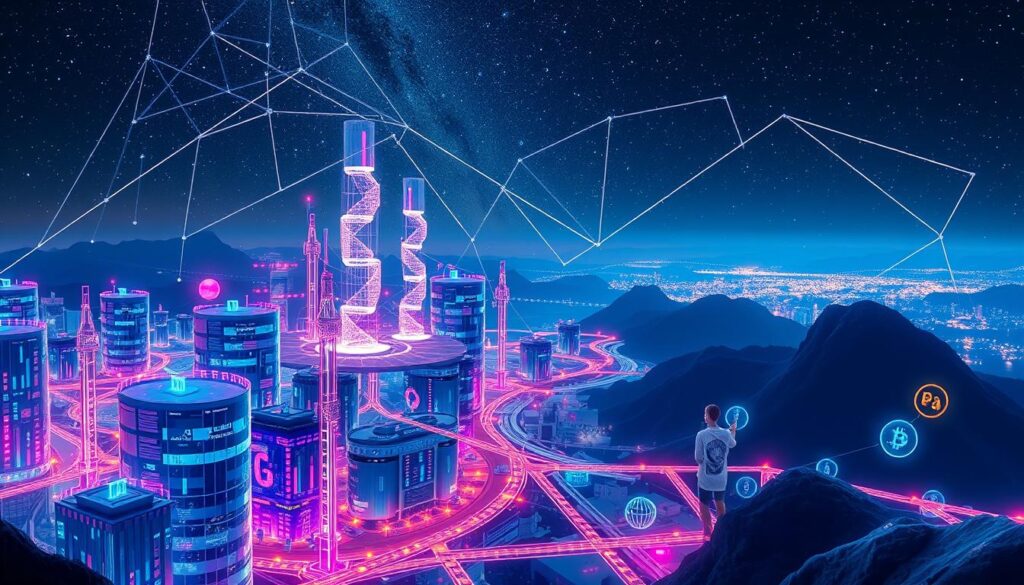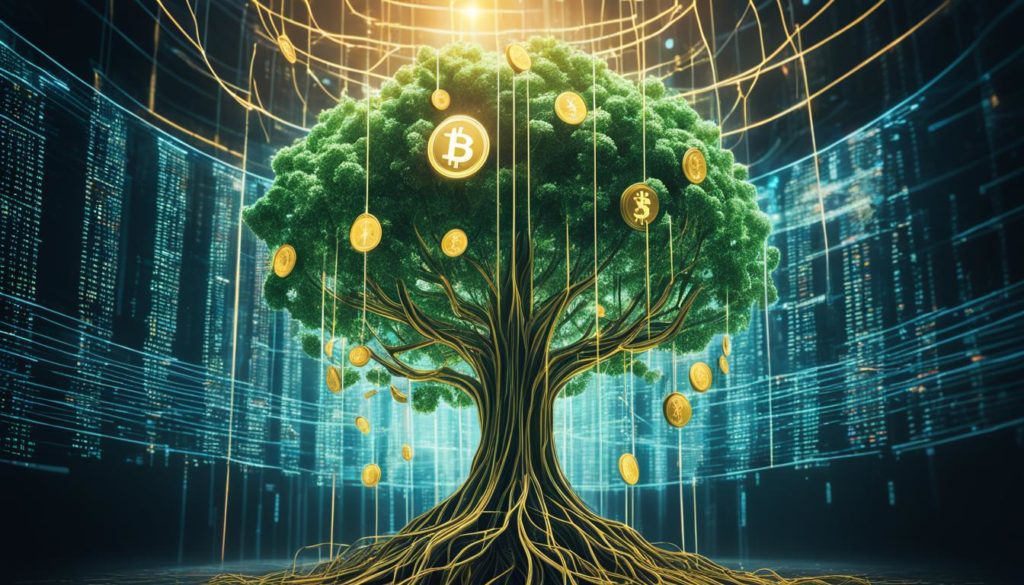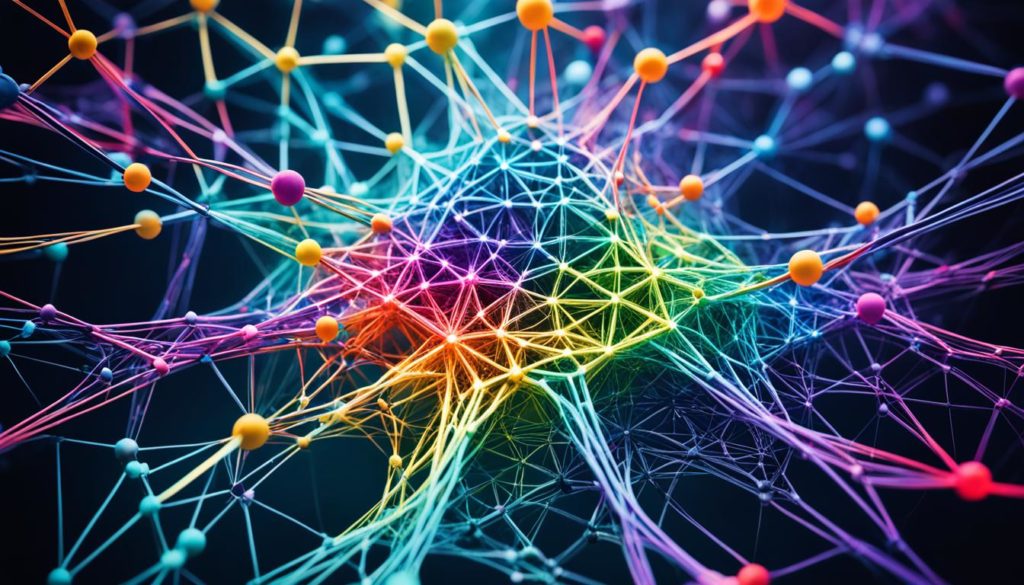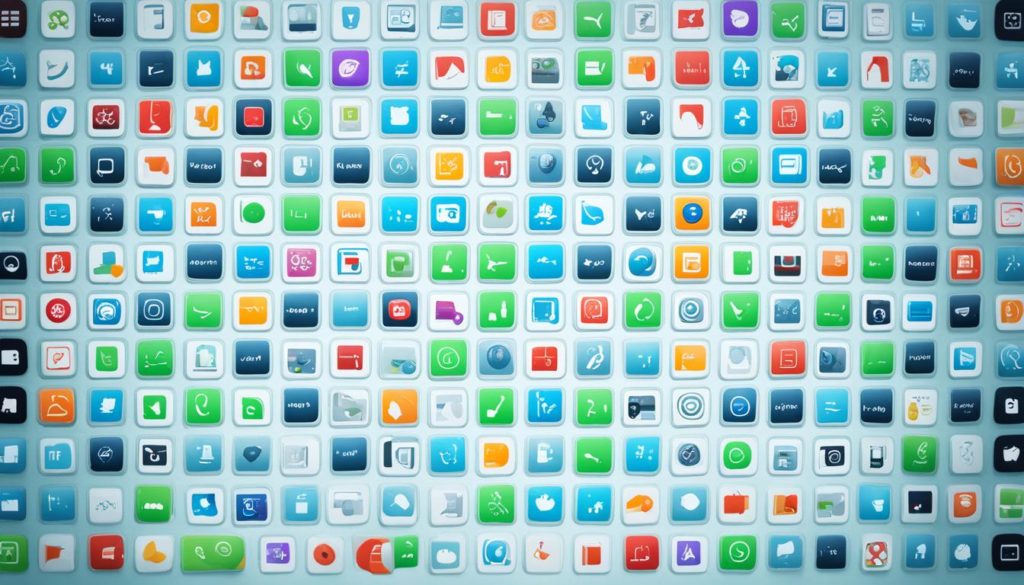
In 2023, more people started using decentralized apps (DApps), showing a market bounce back. This rise happened despite legal hurdles. DApps are key parts of our digital world. They run on networks like Ethereum, using blockchain for better security and control.
DApps lead the way in blockchain innovation. They give users power by removing central control. With Web3, DApps are changing finance, gaming, and social networking. Join us as we explore the endless possibilities of DApps.
Key Takeaways
- DApps are replacing traditional apps on centralized servers, enhancing security and transparency.
- Commonly deployed on platforms like Ethereum for diverse purposes including finance and gaming.
- Operate on blockchain or peer-to-peer networks, empowering users to collectively run the software.
- Smart contracts are foundational, self-executing pieces of code for DApps operations.
- DApps differ from centralized apps by operating without a central authority or single controlling entity.
What Are Decentralized Apps (DApps)?
Decentralized apps, or DApps, are a new kind of digital software. They run on peer-to-peer networks or blockchain systems, not on one computer. Unlike regular apps, DApps don’t rely on a single server. Instead, they use decentralized software for more security and transparency.
This setup keeps user data private and interactions direct. It’s a big change from traditional apps that rely on a single entity.
Definition and Architecture
DApps work on a peer-to-peer network, often on a blockchain like Ethereum. This design means no single person controls the app. It keeps user data safe and builds trust without needing to trust others.
Unlike apps on a single server, DApps are run by many. They use blockchain applications and smart contracts for their autonomy.
Benefits of DApps
DApps bring many benefits to different industries. They offer better security and work more efficiently. They also protect user privacy by controlling data themselves.
Ethereum DApps, part of Web3, are especially flexible and reliable. They cut costs and remove middlemen, making interactions direct. The decentralized setup also ensures data stays the same, thanks to blockchain technology.
Potential Drawbacks
However, DApps face some challenges. One big issue is scalability. Peer-to-peer networks can get too busy, slowing things down. Making DApps user-friendly is also hard.
There are also security risks, like smart contract vulnerabilities. Plus, it’s harder to follow rules because of the decentralized nature. This makes it tough for regulators to keep up.
Despite these hurdles, DApps have a lot of potential. Users need to watch out for scams and unreliable projects. The future of DApps, especially on Ethereum, will depend on solving these problems while keeping their benefits.
| Aspect | Centralized Apps | DApps |
|---|---|---|
| Control | Single Entity | Decentralized |
| Privacy | Limited | Enhanced |
| Data Integrity | Moderate | High |
| Scalability | Higher | Challenging |
| Cost | Higher (Intermediaries) | Lower (Direct Interaction) |
The Technology Behind Decentralized Applications
Decentralized applications (dApps) rely on advanced technologies for their success. These include blockchain networks, peer-to-peer (P2P) networks, smart contracts, and consensus algorithms. Knowing these key elements helps us understand how dApps work and their impact on various industries.
Blockchain and Peer-to-Peer Networks
Blockchain networks are the foundation of dApps. They offer a shared, unchangeable ledger for all transactions. This ensures everything is transparent and secure. P2P networks spread data across many nodes, making the system hard to censor and very secure.
Ethereum can handle about 30 transactions per second. This shows how different platforms can vary in scalability. By 2023, blockchain activity was mostly driven by gaming dApps.
Smart Contracts
Smart contracts are essential for dApps. They are mainly written in Solidity for Ethereum. These contracts automate agreements when certain conditions are met. This eliminates the need for middlemen, making things faster and cheaper.
For more on creating decentralized apps, check out this article.
Consensus Mechanisms
Consensus algorithms keep blockchain networks trustworthy. Proof of Work (PoW) and Proof of Stake (PoS) are the main methods. PoW uses computer power to validate transactions, while PoS uses the amount of stake in the network.
For example, Ethereum handles 30 transactions per second. But Solana, with its unique consensus, can do up to 50,000 transactions per second. These mechanisms are vital for dApps to be reliable and efficient, especially as they grow in 2024.
Decentralized Apps: Real-World Examples
Decentralized apps show the wide range of uses in different fields. They use blockchain to make systems more secure and focused on users.
Finance: Aave and Compound
In finance, Aave and Compound lead the way. Aave lets lenders earn 2-30%+ interest and borrowers get loans up to 80% of their assets. It also has flash loans for quick trading.
Compound helps with lending and borrowing without middlemen. This makes it easier for users to deal directly with each other.
NFTs: OpenSea and NBA Top Shot
NFT marketplaces like OpenSea and NBA Top Shot change how we buy and sell digital items. OpenSea is huge for Ethereum-based NFTs, offering lots of digital art and collectibles. It’s popular because of its wide range and big user base.
NBA Top Shot is big in sports, turning game highlights into tokens. This lets fans and collectors own and trade these moments.
- Opensea: Major marketplace known for Ethereum-based NFTs and extensive selection.
- NBA Top Shot: Focuses on tokenizing basketball highlights, creating a unique sports collectible market.
Gaming: Upland and Splinterlands
Blockchain gaming is exciting, with Upland and Splinterlands leading the way. Upland lets players buy and sell virtual properties tied to real addresses. Splinterlands is a card game where each card is a unique NFT, offering true ownership.
Both games let players earn real money while playing. This is known as play-to-earn.
- Upland: Virtual property trading linked to real-world addresses.
- Splinterlands: Card trading game with each card as an NFT, facilitating actual ownership and trade.
These examples show the power and potential of decentralized apps. They show how blockchain can lead to new and valuable solutions in many fields.
Industry Impacts of Decentralized Apps
Decentralized apps (DApps) are changing many industries. They make things more secure, open, and efficient. This is true for finance, supply chains, healthcare, and education. They are making systems better and more focused on users.
Financial Services
The old financial system was seen as costly, slow, and unfair. But, Blockchain in financial services is changing this. It lets people make direct transactions, saving money and giving more control over their money. DApps are making finance more open to everyone.
Supply Chain Management
DApps are making supply chains more open and traceable. This means goods are easier to track and everyone is more accountable. It helps solve problems like fraud and waste caused by too many middlemen. It makes it clear where goods come from to where they go.
Healthcare and Education
Healthcare records blockchain is making patient data better. It keeps medical records safe and helps doctors work together better. Education DApps are changing education too. They let students and teachers work together more easily. This makes learning more personal and efficient.
| Industry | Major Impact | Key Challenges |
|---|---|---|
| Financial Services | Greater accessibility and reduced transaction costs | Regulatory compliance and user adoption |
| Supply Chain Management | Enhanced transparency and fraud reduction | Scalability and integration with existing systems |
| Healthcare | Improved data sharing and patient outcomes | Data privacy regulations and interoperability |
| Education | Direct collaboration and personalized learning | Scalability and user interface complexities |
Conclusion
DApps are leading the digital revolution, changing how we use the web and manage data. They are built on blockchain and digital ledger technology. This makes them secure, transparent, and decentralized. In 2023, DApps saw an 8% increase in adoption, showing their growing popularity.
DApps have a big impact in many fields. In finance, Uniswap is changing how we do transactions. Power Ledger makes energy trading open and fair. FollowMyVote uses Ethereum for secure voting, showing how DApps can improve our systems.
Gaming and NFTs also benefit from DApps. CryptoKitties lets people own digital pets, showing the power of decentralized apps. Despite challenges, DApps are making progress. They’re improving industries like supply chain and healthcare, making things more accountable and traceable.
The growth of DApps is clear, with a 124% increase in users last year. This shows a big move towards a more open web. The future of DApps looks bright, with many new possibilities waiting to be explored.
FAQ
What are Decentralized Apps (DApps)?
DApps are apps that run on a network of computers, not just one. They aim to remove single points of failure. This makes transactions more private, open, and engaging for users.
Examples include DeFi platforms, NFT marketplaces, and apps in gaming, finance, and healthcare.
How do DApps differ from traditional applications?
DApps don’t rely on a single server like traditional apps do. They use blockchain and smart contracts for data safety and automated transactions. This means users get more security and control over their data.
What technologies are foundational to DApps?
DApps use blockchain and peer-to-peer networks. Blockchain is a shared ledger for transactions. P2P networks spread data across nodes.
Smart contracts automate agreements, and consensus mechanisms like Proof of Work keep the network secure.
What are the benefits of using DApps?
DApps offer better security, transparency, and cost savings. They promote community development and remove central authorities. This gives users more control and encourages innovation.
What are the potential drawbacks of DApps?
DApps face challenges like scalability and security issues. Their experimental nature also raises regulatory hurdles.
Can you give examples of real-world DApps?
Sure! Aave and Compound are leading DeFi apps in finance. OpenSea and NBA Top Shot are changing digital collectibles. Upland and Splinterlands offer play-to-earn models in gaming.
How are DApps impacting different industries?
DApps are changing industries by offering secure and efficient models. In finance, they enable peer-to-peer transactions. In supply chain management, they ensure transparency. In healthcare, they protect sensitive data.
In education, they enable direct collaboration between students and teachers.
What role do smart contracts play in DApps?
Smart contracts are key to DApps. They automate agreements, making transactions secure and transparent. These contracts run on blockchain platforms like Ethereum, building trust in DApps.
What are consensus mechanisms and why are they important for DApps?
Consensus mechanisms help DApps agree on data or network states. They are crucial for network security and trust. Examples include Proof of Work and Proof of Stake.
Future App Studios is an award-winning software development & outsourcing company. Our team of experts is ready to craft the solution your company needs.










